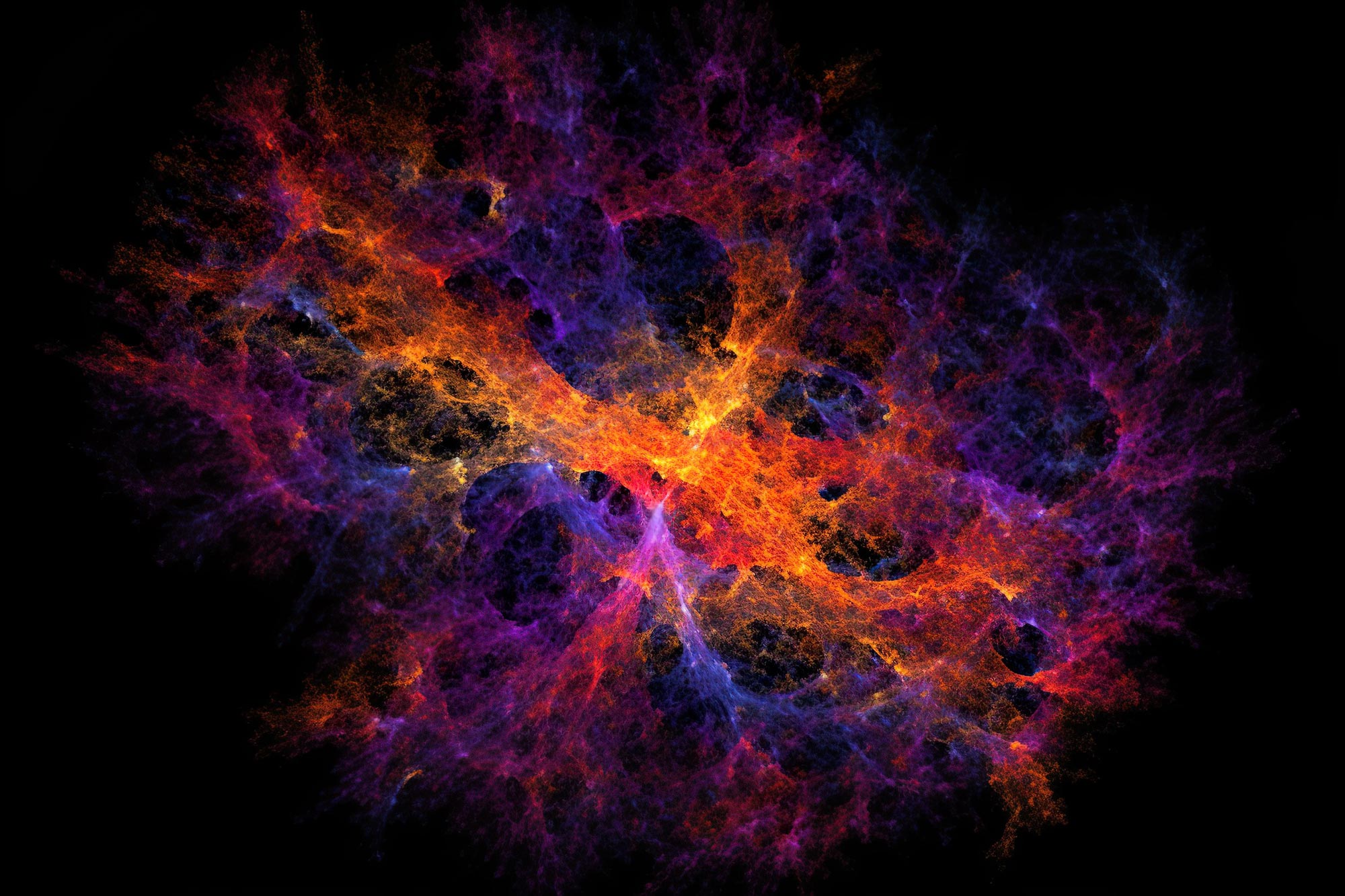
Ein internationales Team aus Astrophysikern und Kosmologen hat fünf Arbeiten eingereicht, aus denen hervorgeht, dass die „Verklumpung“ (S8-Wert) der dunklen Materie des Universums 0,76 beträgt, eine Zahl, die mit anderen Gravitationslinsenuntersuchungen übereinstimmt, jedoch nicht mit dem aus dem kosmischen Mikrowellenhintergrund abgeleiteten Wert von 0,83 .
Ein internationales Wissenschaftlerteam untersuchte mit Advanced Technologies und Hyper Suprime-Cam „Klumpen“ dunkler Materie und fand einen S8-Wert von 0,76, der im Gegensatz zum Wert von 0,83 aus dem kosmischen Mikrowellenhintergrund steht. Diese Diskrepanz könnte auf Messfehler oder ein unvollständiges kosmologisches Standardmodell hinweisen.
Ein internationales Team von Astrophysikern und Kosmologen an verschiedenen Instituten, darunter dem Kavli Institute for the Physics and Mathematics of the Universe (Kavli IPMU), hat eine Reihe von fünf Forschungsarbeiten vorgelegt, in denen der Wert von „Klumpen“ dunkler Materie im Universum bekanntermaßen gemessen wird an Kosmologen wie S.8, von 0,76, was mit Werten übereinstimmt, die bei anderen Gravitationslinsenuntersuchungen im relativ jungen Universum gefunden wurden – aber nicht mit einem Wert von 0,83 übereinstimmt, der aus dem kosmischen Mikrowellenhintergrund abgeleitet wurde, der auf die Ursprünge des Universums zurückgeht, als die Das Universum war etwa 380.000 Jahre alt. Ihre Ergebnisse wurden als vorgedruckte Blätter auf hochgeladen arXiv.
Der Abstand zwischen diesen beiden Werten ist gering, aber da immer mehr Studien beide Werte bestätigen, scheint dies kein Zufall zu sein. Es besteht die Möglichkeit, dass in einer dieser beiden Messungen ein bisher unbekannter Fehler vorliegt oder dass das kosmologische Standardmodell auf interessante Weise unvollständig ist.
Dunkle Energie und dunkle Materie machen 95 % des Universums aus, das wir heute sehen, aber wir wissen sehr wenig darüber, was sie wirklich sind und wie sie sich im Laufe der Geschichte des Universums entwickelt haben. Klumpen dunkler Materie verzerren das Licht entfernter Galaxien durch schwache Gravitationslinsen, ein Phänomen, das in Einsteins allgemeiner Relativitätstheorie vorhergesagt wurde.

Abbildung 1: Beispiel eines mit HSC-SSP erhaltenen Bildes. Bildnachweis: HSC-SSP und NAOJ-Projekt
„Diese Verzerrung ist ein wirklich kleiner Effekt. Die Form einer einzelnen Galaxie wird um einen nicht wahrnehmbaren Betrag verzerrt“, sagte Kavli IPMU-Professor Masahiro Takada, aber die Kombination von Messungen von Millionen von Galaxien ermöglicht es, die Verzerrung mit hoher Präzision zu messen.
Das Standardmodell wird durch nur wenige Zahlen definiert: die Expansionsrate des Universums, die ein Maß dafür ist, wie dicht die Dunkle Materie ist (S8), die relativen Beiträge der Bestandteile des Universums (Materie, dunkle Materie und dunkle Energie), die Gesamtdichte des Universums und eine technische Größe, die beschreibt, wie sich die Agglomeration des Universums auf großen Skalen mit der auf kleinen Skalen verhält.
Kosmologen sind bestrebt, dieses Modell zu testen, indem sie diese Zahlen auf verschiedene Weise einschränken, beispielsweise durch Beobachtung von Schwankungen im kosmischen Mikrowellenhintergrund, durch Modellierung der Expansionsgeschichte des Universums oder durch Messung der Häufung des Universums in der relativ jungen Vergangenheit.
Ein Team unter der Leitung von Astronomen der Kavli IPMU der Universität Tokio,[{“ attribute=““>Nagoya University, Princeton University, and astronomical communities of Japan and Taiwan, have spent the past year teasing out the secrets of this most elusive material, dark matter, using sophisticated computer simulations and data from the first three years of the Hyper Suprime-Cam survey. The observations from this survey used one of the most powerful astronomical cameras in the world, the Hyper Suprime-Cam (HSC) mounted on the Subaru Telescope on the summit of Maunakea in Hawaii.

Figure 2: The measurement results of S8 parameter from HSC-SSP Year 3 data. The chart shows the results from four different methods, which used different parts of the HSC-SSP Year 3 data or combined the HSC-SSP Year 3 data with other data. For comparison, “Planck CMB” shows the measurement result for S8 from the cosmic microwave background data from the Planck satellite. “Other weak lensing results” shows the results from similar weak lensing measurements based on the Dark Energy Survey (DES) and Kilo-Degree Survey (KiDS) data. Credit: Kavli IPMU
Hiding and uncovering the data
The team performed a “blinded analysis.”
“Scientists are human beings, and they do have preferences. Some would love to really find something fundamentally new, while others might feel comfortable if they find results that look consistent with foreseen results. Scientists have become self-aware enough to know that they will bias themselves, no matter how careful they are, unless they carry out their analysis without allowing themselves to know the results until the end,” said Nagoya University Kobayashi-Maskawa Institute for the Origin of Particles and the Universe (KMI) Associate Professor Hironao Miyatake.
To protect the results from such biases, the HSC team hid their results from themselves and their colleagues for months. The team even added an extra obfuscating layer: they ran their analyses on three different galactic catalogs, one real and two fake with numerical values offset by random values. The analysis team didn’t know which of them was real, so even if someone did accidentally see the values, the team wouldn’t know if the results were based on the real catalog or not.
The team spent a year on the blind analysis. On December 3 2022, the team gathered together on Zoom – one Saturday morning in Japan, Friday evening in Princeton – for the “unblinding.” The team unveiled the data, and ran their plots, immediately they saw it was great according to Takada. “Blinded analysis means you cannot take a peak at the results while running the analysis, which was extremely stressful, but as soon I saw the final result, all of that anxiety flew out of the window,” said Kavli IPMU graduate student Sunao Sugiyama.

Figure 3: An example of a 3D distribution of dark matter derived from HSC-SSP. This map is obtained by using the first year’s data, but the present study examined an area on the sky about three times larger than that. Credit: University of Tokyo/NAOJ
A huge survey with the world’s largest telescope camera
HSC is the largest camera on a telescope of its size in the world. The survey that the research team used covers about 420 square degrees of the sky, about the equivalent of 2000 full moons. It is not a single contiguous chunk of sky, but split among six different pieces, each about the size of a person’s outstretched fist. The 25 million galaxies the researchers surveyed are so distant that instead of seeing these galaxies as they are today, the HSC recorded how they were billions of years ago.
Each of these galaxies glows with the fires of tens of billions of suns, but because they are so far away, they are extremely faint, as much as 25 million times fainter than the faintest stars we can see with the naked eye.
For more on this research, see Measuring Dark Matter With Hyper Suprime-Cam Reveals Discrepancy.
References:
“Hyper Suprime-Cam Year 3 Results: Cosmology from Galaxy Clustering and Weak Lensing with HSC and SDSS using the Emulator Based Halo Model” by Hironao Miyatake, Sunao Sugiyama, Masahiro Takada, Takahiro Nishimichi, Xiangchong Li, Masato Shirasaki, Surhud More, Yosuke Kobayashi, Atsushi J. Nishizawa, Markus M. Rau, Tianqing Zhang, Ryuichi Takahashi, Roohi Dalal, Rachel Mandelbaum, Michael A. Strauss, Takashi Hamana, Masamune Oguri, Ken Osato, Wentao Luo, Arun Kannawadi, Bau-Ching Hsieh, Robert Armstrong, Yutaka Komiyama, Robert H. Lupton, Nate B. Lust, Lauren A. MacArthur, Satoshi Miyazaki, Hitoshi Murayama, Yuki Okura, Paul A. Price, Tomomi Sunayama, Philip J. Tait, Masayuki Tanaka and Shiang-Yu Wang, 3 April 2023, Astrophysics > Cosmology and Nongalactic Astrophysics.
arXiv:2304.00704
“Hyper Suprime-Cam Year 3 Results: Measurements of Clustering of SDSS-BOSS Galaxies, Galaxy-Galaxy Lensing and Cosmic Shear” by Surhud More, Sunao Sugiyama, Hironao Miyatake, Markus Michael Rau, Masato Shirasaki, Xiangchong Li, Atsushi J. Nishizawa, Ken Osato, Tianqing Zhang, Masahiro Takada, Takashi Hamana, Ryuichi Takahashi, Roohi Dalal, Rachel Mandelbaum, Michael A. Strauss, Yosuke Kobayashi, Takahiro Nishimichi, Masamune Oguri, Arun Kannawadi, Robert Armstrong, Yutaka Komiyama, Robert H. Lupton, Nate B. Lust, Satoshi Miyazaki, Hitoshi Murayama, Yuki Okura, Paul A. Price, Philip J. Tait, Masayuki Tanaka and Shiang-Yu Wang, 3 April 2023, Astrophysics > Cosmology and Nongalactic Astrophysics.
arXiv:2304.00703
“Hyper Suprime-Cam Year 3 Results: Cosmology from Galaxy Clustering and Weak Lensing with HSC and SDSS using the Minimal Bias Model” by Sunao Sugiyama, Hironao Miyatake, Surhud More, Xiangchong Li, Masato Shirasaki, Masahiro Takada, Yosuke Kobayashi, Ryuichi Takahashi, Takahiro Nishimichi, Atsushi J. Nishizawa, Markus M. Rau, Tianqing Zhang, Roohi Dalal, Rachel Mandelbaum, Michael A. Strauss, Takashi Hamana, Masamune Oguri, Ken Osato, Arun Kannawadi, Robert Armstrong, Yutaka Komiyama, Robert H. Lupton, Nate B. Lust, Satoshi Miyazaki, Hitoshi Murayama, Yuki Okura, Paul A. Price, Philip J. Tait, Masayuki Tanaka and Shiang-Yu Wang, 3 April 2023, Astrophysics > Cosmology and Nongalactic Astrophysics.
arXiv:2304.00705
“Hyper Suprime-Cam Year 3 Results: Cosmology from Cosmic Shear Power Spectra” by Roohi Dalal, Xiangchong Li, Andrina Nicola, Joe Zuntz, Michael A. Strauss, Sunao Sugiyama, Tianqing Zhang, Markus M. Rau, Rachel Mandelbaum, Masahiro Takada, Surhud More, Hironao Miyatake, Arun Kannawadi, Masato Shirasaki, Takanori Taniguchi, Ryuichi Takahashi, Ken Osato, Takashi Hamana, Masamune Oguri, Atsushi J. Nishizawa, Andrés A. Plazas Malagón, Tomomi Sunayama, David Alonso, Anže Slosar, Robert Armstrong, James Bosch, Yutaka Komiyama, Robert H. Lupton, Nate B. Lust, Lauren A. MacArthur, Satoshi Miyazaki, Hitoshi Murayama, Takahiro Nishimichi, Yuki Okura, Paul A. Price, Philip J. Tait, Masayuki Tanaka and Shiang-Yu Wang, 3 April 2023, Astrophysics > Cosmology and Nongalactic Astrophysics.
arXiv:2304.00701
“Hyper Suprime-Cam Year 3 Results: Cosmology from Cosmic Shear Two-point Correlation Functions” by Xiangchong Li, Tianqing Zhang, Sunao Sugiyama, Roohi Dalal, Markus M. Rau, Rachel Mandelbaum, Masahiro Takada, Surhud More, Michael A. Strauss, Hironao Miyatake, Masato Shirasaki, Takashi Hamana, Masamune Oguri, Wentao Luo, Atsushi J. Nishizawa, Ryuichi Takahashi, Andrina Nicola, Ken Osato, Arun Kannawadi, Tomomi Sunayama, Robert Armstrong, Yutaka Komiyama, Robert H. Lupton, Nate B. Lust, Satoshi Miyazaki, Hitoshi Murayama, Takahiro Nishimichi, Yuki Okura, Paul A. Price, Philip J. Tait, Masayuki Tanaka, Shiang-Yu Wang, 3 April 2023, Astrophysics > Cosmology and Nongalactic Astrophysics.
arXiv:2304.00702

„Zertifizierter Unruhestifter. Freundlicher Forscher. Web-Freak. Allgemeiner Bierexperte. Freiberuflicher Student.“





More Stories
Tipps und Tricks für Autofahrer in Cape Canaveral
SpaceX startet bereits am 22. Mai die nächste Generation US-Spionagesatelliten
SpaceX rückt seinem nächsten Starship-Testflug näher, während Starbase weiter expandiert